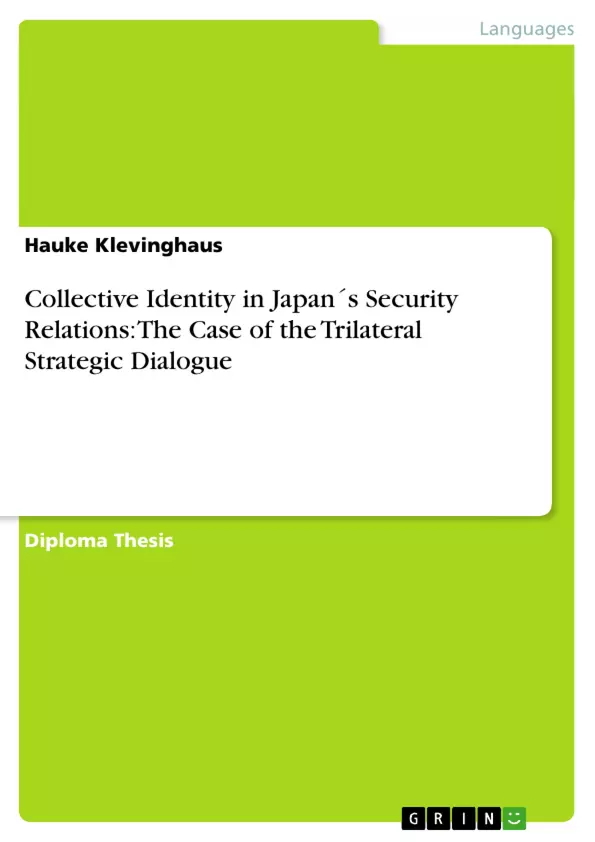This study is an exploration and analysis of the ideational drivers of the Trilateral Strategic Dialogue (TSD) that was concluded in March 2006, between Japan, Australia and the United States. Turning away from materialist explanations of security cooperation, the questions of this study are: Can the conclusion of the TSD and its subsequent evolution be accounted for by a perceived collective identity between the three countries? And what is the Japanese Government´s motivation to expand its alliances architecture? The last decade provides the timeframe for a qualitative analysis. The findings of this study show that the agreement and its following deepening is the result of a strong collective identity constituted by shared norms and democratic values. Moreover, Japan targets with the United States and Australia the establishment of a multilateral community of democratic states in the Asia-Pacific. The results also indicate, however, that collective identity promises peace between liberal states but is hostile towards non-liberal ones.
Inhaltsverzeichnis (Table of Contents)
- Acknowledgements
- Abstract
- Abbreviations
- List of Figures
- Chapter 1 – Introduction
- Chapter 2 Analytical Framework
- 1.1 Methodology
- 1.2 National Identity
- 1.3 Collective Identity
- 1.4 Security Communities
- 1.4.1 Tier One
- 1.4.2 Tier Two
- 1.4.2.1 Structure
- 1.4.2.2 Process
- 1.4.3 Tier Three
- Chapter 3 Case Study
- Part 1 Collective Identity Formation 11/2001-03/2006
- 2.1 Bilateral Cooperation
- 2.1.1 United States-Australia Relations
- 2.1.1.1 The Howard Administration
- 2.1.1.2 Australia's 2003 Foreign and Trade Policy White Paper
- 2.1.1.3 The Iraq War
- 2.1.2 Japan-United States Relations
- 2.1.2.1 9/11 and the War in Afghanistan
- 2.1.2.2 The Iraq Invasion 2003 and the “War on Terror”
- 2.1.2.3 Two SCC Meetings in 2005
- 2.1.2.3.1 The February Meeting
- 2.1.2.3.2 The October Meeting
- 2.1.3 Japan-Australia Relations
- 2.1.3.1 John Howard's Visit to Japan in 2003
- 2.1.3.2 Cooperation in Iraq
- 2.1.3.3 2006 Developments
- 2.1.1 United States-Australia Relations
- 2.2 Trilateral Cooperation
- 2.3 South Korea's Exclusion
- 2.3.1 ROK-Australia Relations
- 2.3.2 ROK-United States Relations
- 2.3.3 ROK-Japan Relations
- 2.1 Bilateral Cooperation
- Part 2 Japan's Evolving Security Framework 05/2006 - 03/2010
- 3.1 The “Japan-U.S. Alliance of the New Century”
- 3.2 The Security Treaty with Australia 2007
- 3.3 A Quadrilateral Relationship with India?
- 3.4 BMD Cooperation with the United States
- 3.5 ACSA with Australia 2010
- 3.6 Convergence with the Obama Administration?
- Part 3 The Greater Strategy
- 4.1 The Strategy: Multilateralism in the Asia-Pacific
- 4.2 The Foundation
- 4.3 The Bush Administration
- 4.4 Australia's Participation
- 4.5 Japan´s Participation and the “Arc of Freedom and Prosperity”
- Part 1 Collective Identity Formation 11/2001-03/2006
- Chapter 4 Conclusion
- Bibliography
Zielsetzung und Themenschwerpunkte (Objectives and Key Themes)
This study analyzes the Trilateral Strategic Dialogue (TSD) between Japan, Australia, and the United States, exploring its ideational drivers and the role of collective identity in its formation. It seeks to understand the motivation behind Japan's expansion of its alliance architecture and the implications of this development for regional security.- The role of collective identity in international security cooperation
- The formation and evolution of the Trilateral Strategic Dialogue
- Japan's motivations for expanding its alliances in the Asia-Pacific
- The impact of shared norms and values on security partnerships
- The relationship between collective identity and the promotion of peace and stability
Zusammenfassung der Kapitel (Chapter Summaries)
- Chapter 1 – Introduction: The introduction establishes the context of the study by discussing the importance of understanding the ideational drivers of security cooperation in the Asia-Pacific region. It outlines the research question and the theoretical framework employed in the study.
- Chapter 2 Analytical Framework: This chapter delves into the theoretical framework of the study, focusing on concepts such as national identity, collective identity, and security communities. It elaborates on the different tiers of security communities and provides a methodology for analyzing the case study.
- Chapter 3 Case Study: This chapter presents the main body of the research, examining the case study of the Trilateral Strategic Dialogue (TSD) in detail. It covers the period from 2001 to 2010, exploring the bilateral and trilateral cooperation dynamics between Japan, Australia, and the United States, as well as the exclusion of South Korea.
Schlüsselwörter (Keywords)
This study explores the intersection of collective identity, security cooperation, and regional politics in the Asia-Pacific. It investigates the drivers of Japan's security alliances and the role of shared norms and values in shaping the Trilateral Strategic Dialogue. Key concepts include collective identity, security communities, regional security, democratic values, the "Arc of Freedom and Prosperity," and the "Japan-U.S. Alliance of the New Century."- Quote paper
- Hauke Klevinghaus (Author), 2010, Collective Identity in Japan´s Security Relations: The Case of the Trilateral Strategic Dialogue, Munich, GRIN Verlag, https://www.grin.com/document/202780



